- Apricot: The Perfect Fruit for Your Garden
- Why grow apricots in your garden?
- How to grow apricots in your garden
- Common apricot varieties
- Growing Apricots in Your Garden
- 1. Climate and Location
- 2. Planting
- 3. Watering
- 4. Fertilizing
- 5. Pruning
- 6. Pest and Disease Control
- 7. Harvesting
- Choosing the Right Apricot Species for Your Area
- 1. Prunus armeniaca
- 2. Prunus sibirica
- 3. Prunus mandshurica
- Popular Apricot Varieties for Your Garden
- Moorpark
- Goldrich
- Royal Rosa
- Tilton
- Patterson
- Tomcot
- Blenheim
- Harcot
- Harglow
- Caring for Your Apricot Trees
- Watering
- Fertilizing
- Pruning
- Pest and Disease Control
- Harvesting
- Winter Protection
- Conclusion
- Harvesting and Storing Apricots
- Harvesting Apricots
- Storing Apricots
- Tips for Enjoying Fresh Apricots
- Common Apricot Pests and Diseases
- Pests
- Diseases
- Troubleshooting Apricot Tree Problems
- Pest Infestation
- Disease
- Poor Fruit Set
- Watering Problems
- Environmental Factors
- Question-answer:
- What is the best time to plant apricot trees?
- Can apricot trees grow in pots or containers?
- What are some common pests and diseases that affect apricot trees?
- How long does it take for an apricot tree to bear fruit?
- What are some popular apricot varieties for home gardens?
- Do apricot trees require a lot of water?
- How tall do apricot trees usually grow?
- Video: 3 Fruits Every Beginner Gardener NEEDS To Plant IMMEDIATELY That Will Feed You For Life

Apricots are delicious, golden fruits that are a favorite among gardeners. Not only are they a sweet and tangy treat, but they also offer a variety of health benefits. Apricots are packed with vitamins A and C, fiber, and antioxidants, making them a nutritious addition to any diet. They are also low in calories and have been known to promote healthy digestion and help with weight management.
If you’re thinking about growing apricots in your garden, you’re in luck! Apricot trees are relatively easy to grow and can thrive in a variety of climates. They prefer a sunny location with well-drained soil and require regular watering to ensure healthy growth. With proper care, apricot trees can produce an abundant harvest of delicious fruits that you can enjoy right from your own backyard.
When it comes to apricot varieties, there are several options to choose from. The most common species of apricot is Prunus armeniaca, which includes both early and late blooming varieties. Early blooming varieties are ideal for areas with cold winters, as they can withstand frost and flower before the last frost date. Late blooming varieties are better suited for regions with mild winters, as they bloom later in the season and are less likely to be damaged by late spring frost.
If you’re looking for a sweet and juicy apricot, the ‘Moorpark’ variety is a popular choice. This variety is known for its large, flavorful fruits that are perfect for fresh eating or making jams and preserves. Another delicious variety is the ‘Goldcot’, which has a sweet, aromatic flavor and is prized for its excellent canning qualities.
Whether you’re a seasoned gardener or just starting out, growing apricots can be a rewarding experience. With the right care and attention, you can enjoy a bountiful harvest of these delicious fruits right from your own garden. So why not give it a try and add apricots to your garden this season?
Apricot: The Perfect Fruit for Your Garden
Growing your own fruit in your garden can be a rewarding experience, and one fruit that is perfect for any garden is the apricot. Apricots are not only delicious, but they are also relatively easy to grow and have a number of health benefits.
Why grow apricots in your garden?
- Delicious fruit: Apricots have a rich, sweet flavor that is hard to beat.
- Easy to grow: Apricot trees are relatively low-maintenance and can thrive in a variety of climates.
- Beautiful blossoms: In addition to their tasty fruit, apricot trees are also known for their beautiful, fragrant blossoms in the spring.
- Space-saving: Apricot trees can be grown in containers or trained to grow against a wall, making them ideal for small gardens.
- Health benefits: Apricots are a good source of vitamins A and C, fiber, and antioxidants, making them a healthy addition to your diet.
How to grow apricots in your garden
- Choose the right variety: There are many different varieties of apricots available, so choose one that is suitable for your climate and growing conditions.
- Plant in the right location: Apricots thrive in full sun and well-drained soil. Choose a spot in your garden that receives at least 6-8 hours of sunlight per day.
- Prepare the soil: Before planting, amend the soil with organic matter to improve its fertility and drainage.
- Plant the tree: Dig a hole that is slightly wider and deeper than the root ball of the tree. Place the tree in the hole and gently backfill with soil, firming it down gently.
- Water regularly: Apricots need regular watering, especially during dry spells. Keep the soil evenly moist, but avoid overwatering.
- Prune and fertilize: Prune your apricot tree in late winter or early spring to remove any dead or diseased wood. Fertilize the tree with a balanced fertilizer in the spring and summer.
- Harvest and enjoy: Apricots are usually ready to harvest in late spring or early summer. Pick the fruit when it is fully ripe and enjoy it fresh or use it in your favorite recipes.
Common apricot varieties
| Variety | Description |
|---|---|
| Early Blush | One of the earliest ripening varieties, with large, flavorful fruit. |
| Blenheim | A popular variety with medium-sized, orange fruit and a sweet flavor. |
| Tilton | A reliable and productive variety, known for its juicy, tangy fruit. |
| Harcot | A newer variety with a sweet, rich flavor and a high sugar content. |
As you can see, growing apricots in your garden is a great way to enjoy delicious fruit and add beauty to your landscape. So why not give it a try and start growing your own apricots today?
Growing Apricots in Your Garden
Apricots are delicious fruits that can be grown in your own garden. With the right care and maintenance, you can enjoy a bountiful harvest of apricots year after year. Here are some tips to help you successfully grow apricots in your garden.
1. Climate and Location
Apricots thrive in warm, dry climates with cold winters. They require a chilling period in winter to set fruit. Choose a sunny location in your garden with well-draining soil. Avoid areas prone to frost or excessive wind.
2. Planting
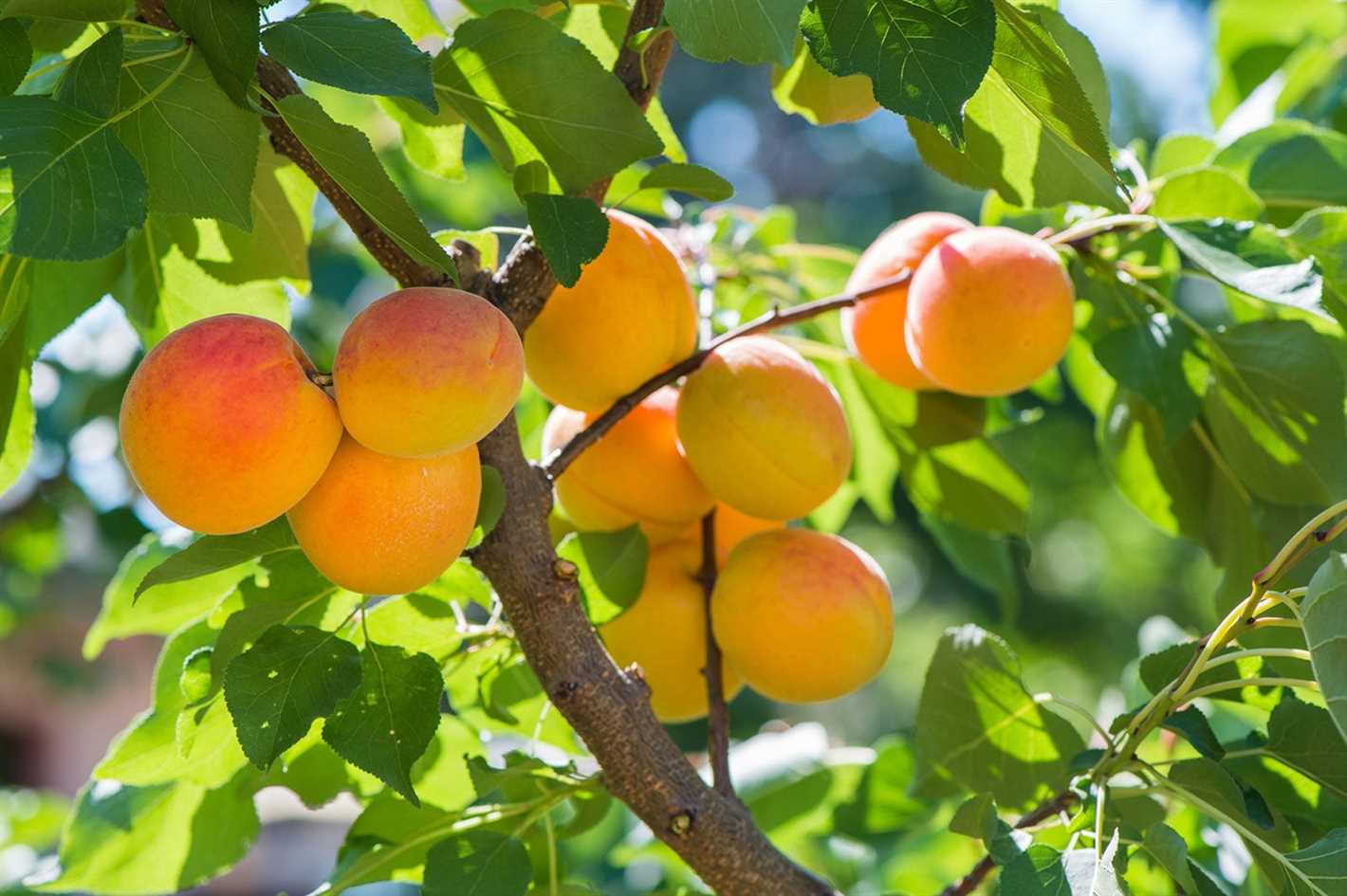

Apricots can be grown from seeds, but it is recommended to plant grafted apricot trees for better results. When planting, make sure the soil is well-prepared by adding organic matter and loosening it. Dig a hole twice the size of the rootball and place the tree in the hole, making sure the bud union is at least 2 inches above the soil level.
3. Watering
Apricot trees need regular watering, especially during the growing season. Water deeply and thoroughly, making sure the soil is moist but not saturated. Avoid overwatering, as it can lead to root rot.
4. Fertilizing
Provide a balanced fertilizer for your apricot trees in early spring, before new growth appears. Use a fertilizer specifically formulated for fruit trees and follow the manufacturer’s instructions for application rates. Avoid overfertilizing, as it can result in excessive vegetative growth instead of fruit production.
5. Pruning
Prune your apricot trees during winter or early spring to remove dead or diseased branches and to improve air circulation. This will help prevent fungal diseases and promote healthy growth. Remove any suckers or water sprouts that emerge from the base of the tree.
6. Pest and Disease Control
Common pests that can affect apricot trees include aphids, mites, and peach twig borers. Monitor your trees regularly and take appropriate measures to control pests if necessary. Apricot trees can also be susceptible to diseases like brown rot, powdery mildew, and bacterial canker. Apply appropriate fungicides or seek professional advice if you notice any signs of disease.
7. Harvesting
Apricots are ready for harvest when they are firm but slightly soft and have a deep orange color. Gently twist the fruit to detach it from the tree or use a pair of clippers. Avoid pulling or tugging on the fruit, as this can damage the tree. Store apricots in a cool, dry place or enjoy them fresh!
By following these tips, you can successfully grow apricots in your garden and enjoy the delicious fruits of your labor.
Choosing the Right Apricot Species for Your Area
When it comes to growing apricots in your garden, it’s important to choose the right species that is suitable for your climate and growing conditions. Here are some popular apricot species and their characteristics to help you make the best decision for your area:
1. Prunus armeniaca
Prunus armeniaca, also known as the European apricot, is one of the most common apricot species. It is suitable for areas with a temperate climate and requires a chilling period during winter to set fruit. European apricots are known for their delicious flavor and are often used for eating fresh or making jams and preserves.
Characteristics of Prunus armeniaca:
- Requires a chilling period of around 600-900 hours below 45°F (7°C).
- Flowers early and fruits ripen in early summer.
- Has a semi-dwarf size, making it suitable for smaller gardens.
- Fruit size varies from small to medium.
2. Prunus sibirica
Prunus sibirica, commonly known as the Siberian apricot, is a hardy species that can withstand colder climates compared to other apricot varieties. It is native to Siberia and is often used as rootstock for grafting other apricot varieties. While the fruit of the Siberian apricot is not as flavorful as other species, it is still edible and can be used for making preserves or dried fruits.
Characteristics of Prunus sibirica:
- Tolerates cold climates and frost better than other apricot varieties.
- Has a spreading growth habit.
- Requires cross-pollination with another apricot variety to set fruit.
- Produces small to medium-sized fruit with a tart flavor.
3. Prunus mandshurica
Prunus mandshurica, also known as the Manchurian apricot, is a species native to Northeast Asia. It is well-adapted to cold climates and is often used as rootstock for grafting other apricot varieties. The fruit of the Manchurian apricot is similar to the European apricot in flavor and is suitable for eating fresh or making preserves.
Characteristics of Prunus mandshurica:
- Tolerates cold climates and can withstand temperatures as low as -40°F (-40°C).
- Has a spreading growth habit.
- Fruits ripen in late summer.
- Fruit size varies from small to medium.
Before choosing an apricot species for your garden, it’s important to consider your climate, the chilling requirements of the species, and the ultimate use of the fruit. By selecting the right apricot species, you can enjoy a bountiful harvest of delicious apricots straight from your own garden.
Popular Apricot Varieties for Your Garden
Moorpark
The Moorpark apricot is a popular variety known for its large size and tangy flavor. It has a rich, orange color and firm flesh, making it ideal for eating fresh or incorporating into recipes. The Moorpark apricot tree is also relatively easy to grow and is known for its abundant harvest.
Goldrich
Goldrich apricots are prized for their sweet, juicy flavor and firm texture. They have a golden-yellow skin and flesh, and their flavor is often described as mild and honey-like. Goldrich apricot trees are vigorous growers and produce high yields of fruit, making them a great choice for home gardeners.
Royal Rosa
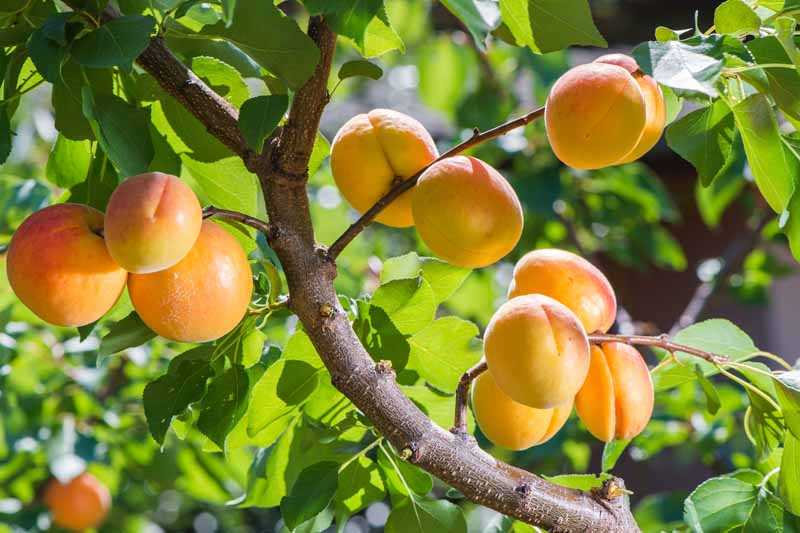

Royal Rosa apricots are small to medium-sized with a reddish-orange skin and sweet, flavorful flesh. They are known for their excellent taste and aroma, often compared to a blend of apricots and peaches. Royal Rosa apricot trees are self-fertile and have a compact growth habit, making them suitable for smaller gardens.
Tilton
Tilton apricots are popular for their tart, tangy flavor and bright orange color. They have a firm yet melting flesh, making them great for eating fresh or for use in jams, jellies, and desserts. Tilton apricot trees are relatively easy to grow and are known for their consistent yields.
Patterson
Patterson apricots are prized for their large size, excellent flavor, and juicy texture. They have a golden-orange skin with a slight blush and firm, sweet flesh. Patterson apricot trees are known for their vigorous growth and high fruit production.
Tomcot
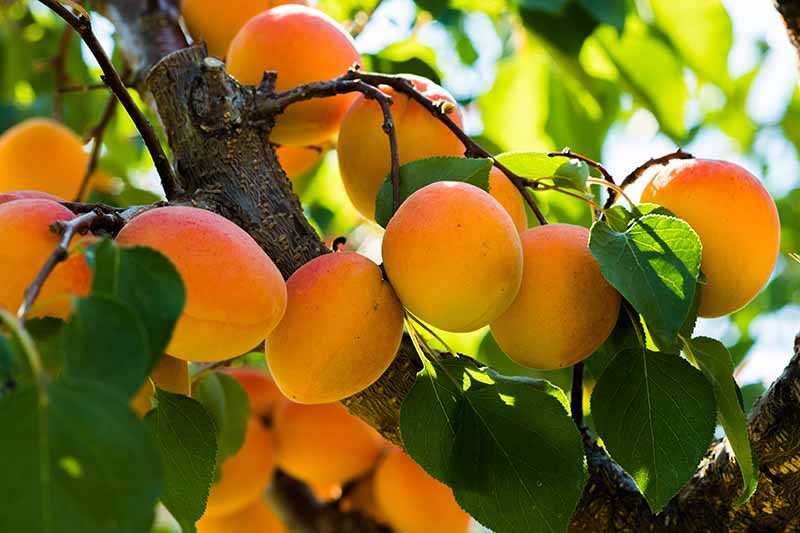

Tomcot apricots are known for their early ripening and exceptional flavor. They have a golden-orange skin and sweet, juicy flesh. Tomcot apricot trees are well-suited for regions with a shorter growing season and are resistant to late spring frosts.
Blenheim
Blenheim apricots, also known as Royal, are one of the most popular apricot varieties. They have a rich, sweet-tart flavor and a vibrant orange color. Blenheim apricot trees are vigorous growers and are known for their high fruit production and resistance to diseases.
Harcot
Harcot apricots are known for their large size, sweet flavor, and juicy texture. They have a bright orange skin and golden flesh. Harcot apricot trees are self-fertile and have a spreading growth habit.
Harglow
Harglow apricots are prized for their large size, sweet taste, and firm flesh. They have a golden-orange skin with a slight blush, and their flavor has been described as rich and aromatic. Harglow apricot trees are productive and have good resistance to diseases.
Disclaimer: The availability of these apricot varieties may vary depending on your location and local nursery stock. It is always recommended to consult with local gardening experts or nurseries to determine the best apricot varieties for your specific climate and growing conditions.
Caring for Your Apricot Trees
Watering
Apricot trees need regular watering to ensure their growth and fruit production. As a general guideline, water the trees deeply every 2-3 weeks during the growing season. This will help to promote deep root growth and make the trees more drought-tolerant. However, be careful not to overwater, as this can lead to root rot. Monitor the soil moisture levels and adjust the watering schedule accordingly.
Fertilizing
Apricot trees benefit from regular fertilization to provide them with essential nutrients. Apply a balanced fertilizer in early spring just before the tree begins to break dormancy. Use a slow-release fertilizer and follow the manufacturer’s instructions for proper application rates. Additionally, you can provide a nitrogen-rich fertilizer in mid-summer to support continued growth and fruit development.
Pruning
Proper pruning is important for the health and shape of your apricot trees. Prune the trees during late winter or early spring while they are still dormant. Remove any dead, damaged, or diseased branches. Thin out overcrowded branches to improve air circulation and allow for better light penetration. Prune back the top of the tree to control its height and maintain a desirable shape.
Pest and Disease Control
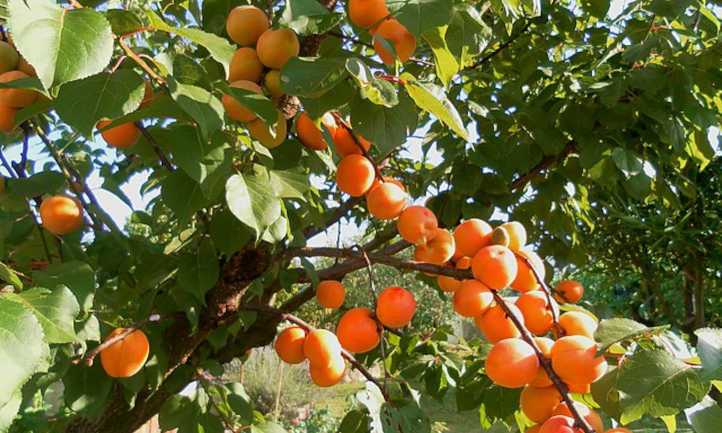

Apricot trees are susceptible to various pests and diseases, including aphids, scale insects, and brown rot. Regularly inspect your trees for signs of infestation or disease. If detected, apply appropriate organic or chemical controls to manage the problem. Consider using natural predators or beneficial insects to help control pest populations.
Harvesting
Apricots are typically ready for harvest in mid to late summer, depending on the variety. Look for fruits that are fully colored and slightly soft to the touch. Carefully remove the fruits from the tree without damaging them. Apricots are fragile, so handle them with care to avoid bruising or splitting. Enjoy your fresh apricots right away or use them in various culinary preparations.
Winter Protection
Apricot trees can be vulnerable to frost and extreme cold temperatures. To protect them during winter, wrap the trunks with burlap or special tree wrap to insulate them. Apply a layer of mulch around the base of the tree to help retain soil moisture and provide additional insulation. If severe cold is expected, consider using frost blankets or other protective coverings to shield the trees.
Conclusion
Caring for your apricot trees involves proper watering, fertilizing, pruning, pest and disease control, harvesting, and winter protection. By providing the necessary care, your apricot trees will thrive and reward you with a bountiful harvest of delicious fruits.
Harvesting and Storing Apricots
Harvesting Apricots
Apricots are usually ready for harvest in late spring or early summer, depending on the climate and variety. It is important to pick apricots at the right stage of ripeness to ensure the best flavor and texture. Here are some tips for harvesting apricots:
- Check for ripeness by gently squeezing an apricot. It should be slightly soft and give a little under pressure.
- Look for apricots with a vibrant orange or yellow color. This indicates that they are fully ripe.
- Avoid picking apricots that are still firm and green, as they will not ripen properly off the tree.
- Use a pair of garden shears or pruners to gently cut the apricots from the tree, leaving a small stem attached.
- Handle the apricots with care to prevent bruising or damaging the fruit.
Storing Apricots
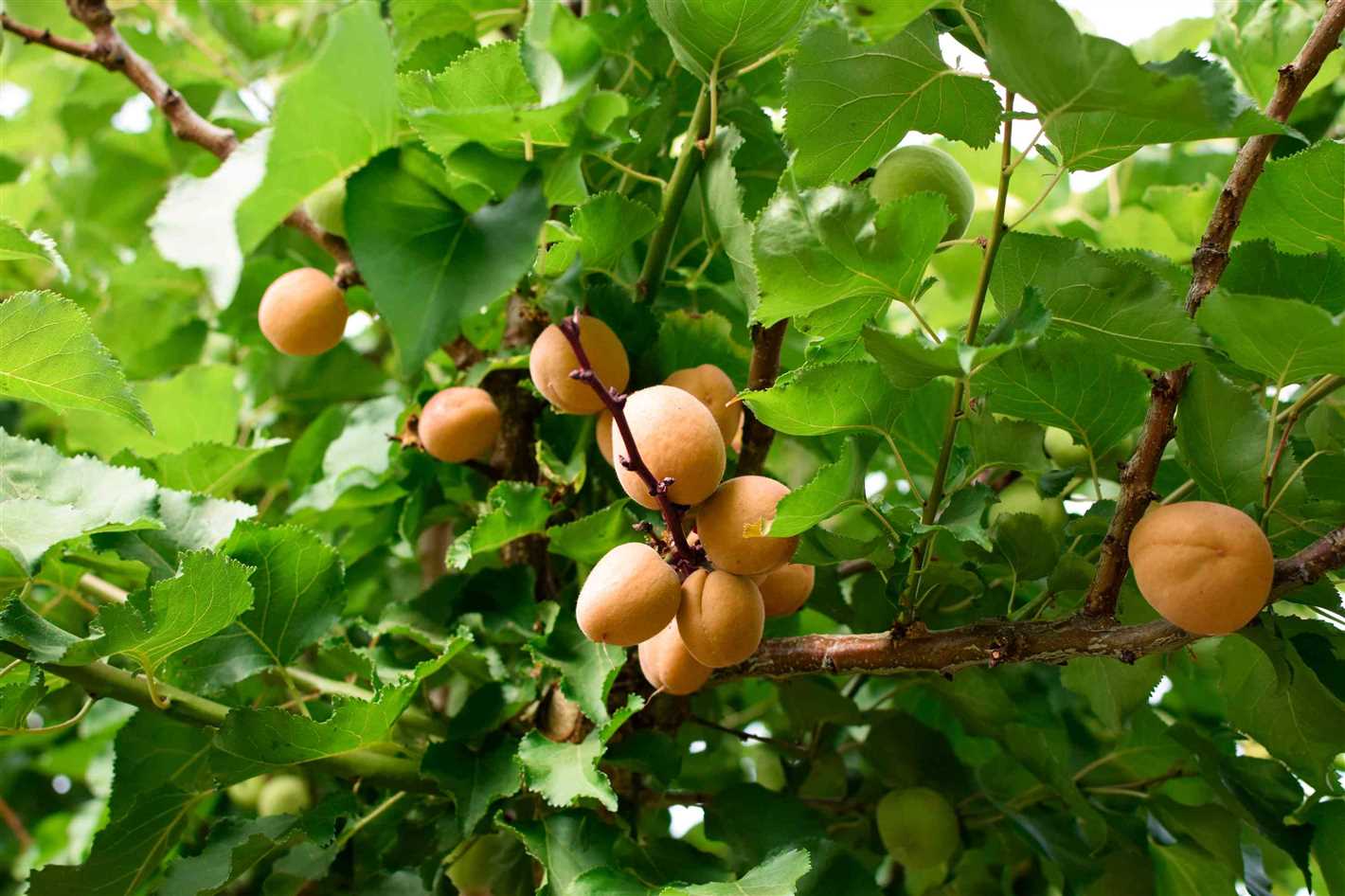

Apricots have a short shelf life and are best enjoyed when fresh. However, if you have more apricots than you can consume immediately, here are some tips for storing them:
- Store ripe apricots in the refrigerator in a breathable container, such as a paper bag or a perforated plastic bag. This helps to retain their flavor and prevents them from becoming overly soft.
- Do not wash apricots until you are ready to eat them, as moisture can speed up the ripening process and lead to mold growth.
- Alternatively, you can freeze apricots for long-term storage. To freeze apricots, wash, pit, and slice them, then spread the slices in a single layer on a baking sheet and freeze. Once frozen, transfer the slices to airtight containers or freezer bags.
- Frozen apricots can be used in smoothies, baked goods, or thawed and enjoyed on their own.
Tips for Enjoying Fresh Apricots
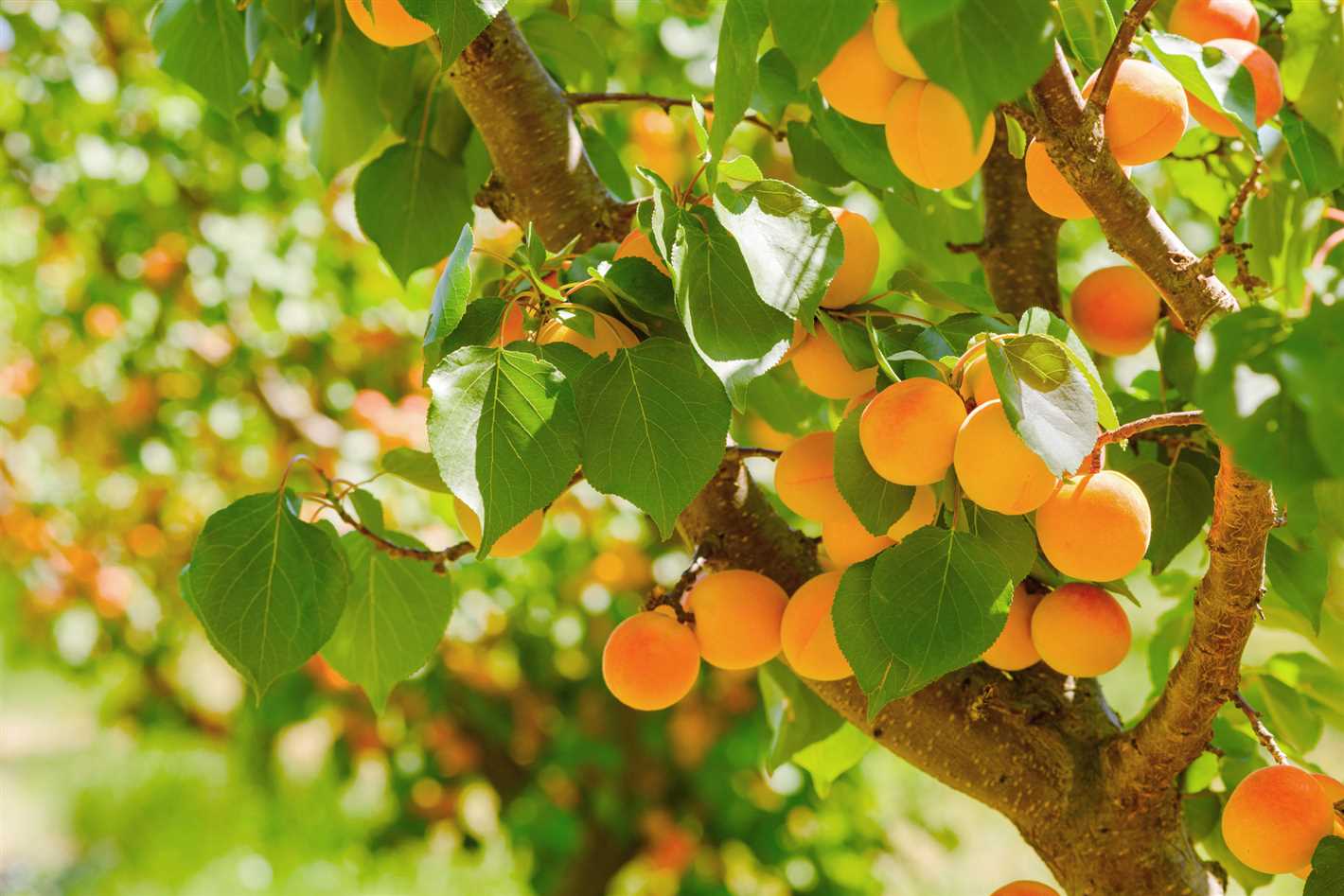

Apricots are delicious when eaten fresh, and there are many ways to enjoy them:
- Eat them as a snack on their own.
- Slice them and add them to salads for a sweet and tangy twist.
- Use them in desserts like pies, tarts, crumbles, or cobblers.
- Puree them to make apricot jam or preserves.
- Blend them into smoothies for a burst of fruity flavor.
- Bake them into breads or muffins for a sweet and moist treat.
By following these tips for harvesting, storing, and enjoying apricots, you can make the most of this delicious and versatile fruit.
Common Apricot Pests and Diseases
Pests
- Aphids: These small insects suck the sap from apricot leaves and can cause stunted growth. Regularly inspect the leaves for signs of aphid infestation and treat with insecticidal soap if necessary.
- Mites: Apricots are susceptible to various species of mites, including spider mites. These pests cause yellowing and bronzing of the leaves. Apply miticidal sprays or use predatory mites to control mite populations.
- Fruit Flies: Fruit flies are a common problem in apricot trees. They lay their eggs in the fruit, causing it to rot and become inedible. Use fruit fly traps and remove affected fruits to prevent infestation.
- Codling Moths: Codling moths are a major pest for apricot trees. The caterpillars tunnel into the fruit, causing it to rot. Hang pheromone traps and apply insecticides at the appropriate times to control these pests.
Diseases
- Leaf Curl: Leaf curl is a fungal disease that affects many stone fruit trees, including apricots. Infected leaves become distorted and curled, and the tree’s overall health and yield can be affected. Apply fungicides in late winter or early spring to prevent leaf curl.
- Brown Rot: Brown rot is a common disease in apricot trees, especially in warm and humid conditions. Infected fruit develops brown spots and becomes soft and rotten. Remove and destroy infected fruits and maintain good air circulation to prevent the spread of brown rot.
- Shot Hole Disease: Shot hole disease is caused by a fungus and leaves small holes in the leaves of apricot trees. Infected leaves may also have red or purple spots. Apply fungicides to prevent the spread of shot hole disease.
- Root Rot: Apricot trees can be susceptible to root rot, especially in poorly drained soils. Symptoms include yellowing leaves, stunted growth, and wilting. Improve drainage and avoid overwatering to prevent root rot.
Regular monitoring and proper cultural practices, such as ensuring good air circulation and maintaining overall tree health, can help prevent and manage these pests and diseases in apricot trees.
Troubleshooting Apricot Tree Problems
Apricot trees can sometimes encounter problems that may affect their growth and productivity. Here are some common issues and how to troubleshoot them:
Pest Infestation
Aphids, mites, and scale insects are some common pests that can infest apricot trees. They can cause damage to the leaves, buds, and fruit. To address this problem, you can use insecticidal soap or horticultural oil to control the infestation. Be sure to follow the instructions on the product label and apply it when the tree is not in bloom.
Disease
Apricot trees are susceptible to various diseases such as brown rot, bacterial canker, and powdery mildew. To prevent the spread of disease, make sure to remove and destroy any infected branches or fruits. It is also important to practice good sanitation by cleaning up fallen leaves and debris around the tree. Fungicides can be used as a preventative measure, but make sure to choose a product that is labeled for apricots and follow the instructions carefully.
Poor Fruit Set
If your apricot tree is flowering, but not producing fruit, there could be several reasons. Lack of pollination is a common issue, especially if there are no honeybees or other pollinators in the area. You can try hand-pollination by transferring pollen from one flower to another using a small brush. Another possible reason is inadequate or imbalanced fertilization. Make sure to provide the tree with proper nutrients, especially nitrogen, phosphorus, and potassium, according to the recommendations for apricots.
Watering Problems
Overwatering or underwatering can lead to stress and various problems for apricot trees. If the tree is not receiving enough water, the leaves may turn yellow and wilt. On the other hand, excessive watering can cause root rot and other diseases. It is important to provide the tree with a consistent and well-draining watering schedule. Monitor the soil moisture and adjust the watering accordingly.
Environmental Factors
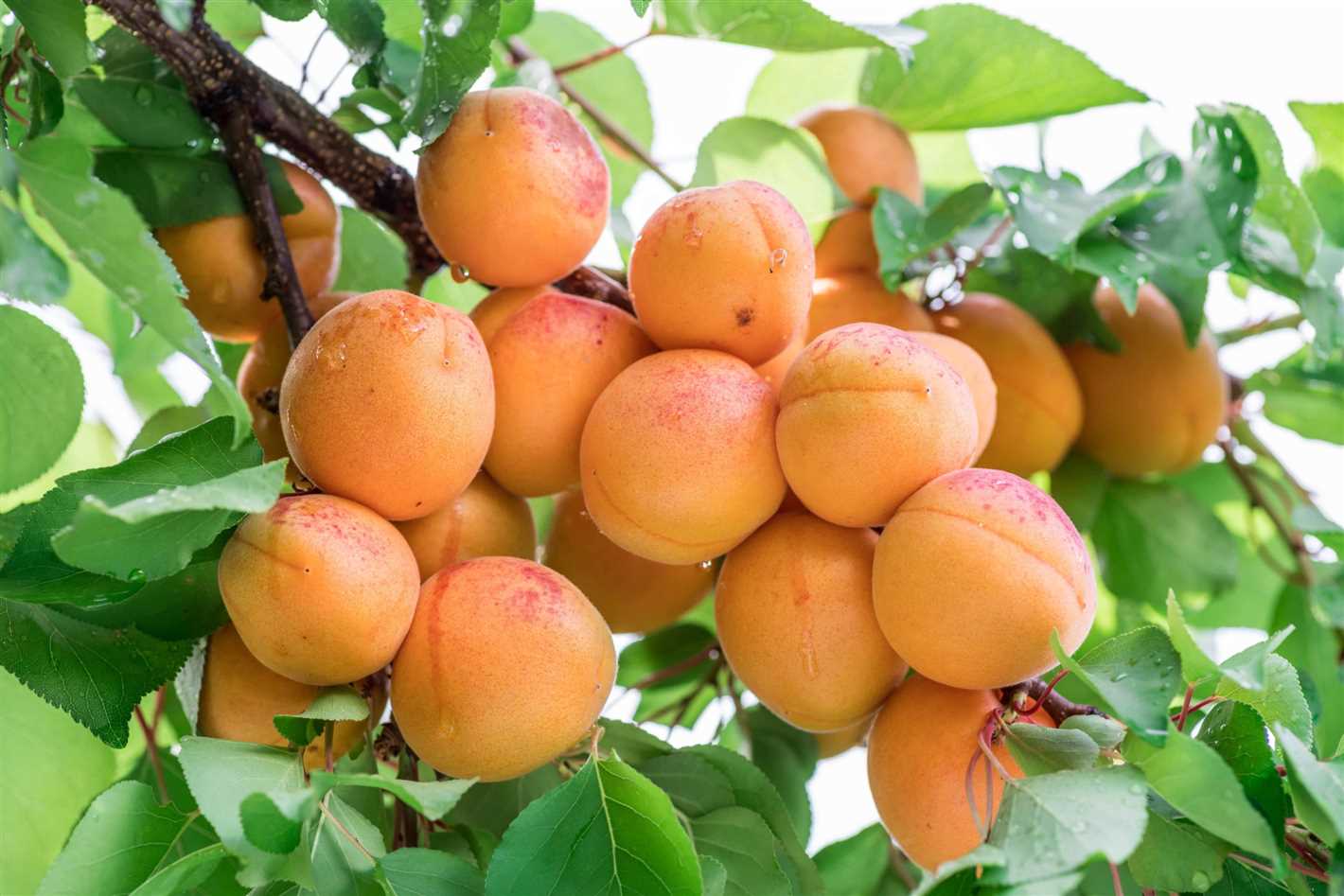

Apricot trees are susceptible to frost damage, especially during their blooming period. If frost is expected, you can protect the tree by covering it with a frost cloth or moving it to a sheltered location. Extreme heat can also cause stress and sunburn on the leaves and fruit. You can provide shade with the help of shade cloth or by strategically planting other trees or shrubs to block some of the direct sunlight.
By identifying and addressing these common problems, you can help your apricot tree thrive and produce a bountiful harvest.
Question-answer:
What is the best time to plant apricot trees?
The best time to plant apricot trees is in late winter or early spring, before the buds start to swell and break dormancy.
Can apricot trees grow in pots or containers?
Yes, apricot trees can be grown in pots or containers, but they will require regular pruning and care to keep them small and manageable.
What are some common pests and diseases that affect apricot trees?
Some common pests of apricot trees include aphids, mites, and fruit flies. Common diseases include brown rot, powdery mildew, and bacterial canker.
How long does it take for an apricot tree to bear fruit?
Apricot trees typically begin producing fruit in 2-4 years, depending on the variety and growing conditions.
What are some popular apricot varieties for home gardens?
Some popular apricot varieties for home gardens include ‘Blenheim’, ‘Moorpark’, and ‘Royal’. These varieties are known for their delicious flavor and excellent fruit quality.
Do apricot trees require a lot of water?
Apricot trees are relatively drought-tolerant, but they will benefit from regular watering, especially during dry periods. It is important to prevent the soil from becoming too dry, as this can lead to fruit drop and poor fruit quality.
How tall do apricot trees usually grow?
Apricot trees can grow to be 15-25 feet tall, depending on the variety and growing conditions. However, with proper pruning and training, they can be kept smaller and more manageable.







